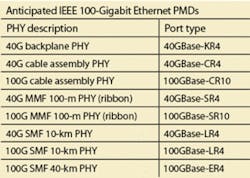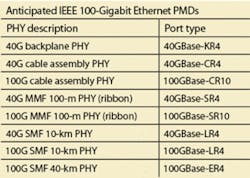by Stephen Hardy
Like the prototype "cars of tomorrow" that always draw a crowd at the major auto shows, demonstrations of 100-Gbit/sec technology have proven a popular feature at communications trade shows this year. Prototypes on display at OFC/NFOEC this past February and last month's NXTcomm indicate that consensus on technology directions has begun to form in both the standards bodies and the industry as a whole.
The IEEE 802.3ba task force charged with developing the specifications for 40- and 100-Gigabit Ethernet (100GbE) has focused so far on multilane (either four or 10) transmission across copper, singlemode fiber, and multimode fiber. Reach will extend from 100 m to 40 km, and the standard also will include a backplane specification (see table). Depending upon the optical PMD, either parallel optics or CWDM will be used.
With a completion goal of 2010, the task force took several steps forward in May, including the approval of a baseline proposal for a multilane distribution (MLD) protocol architecture for the 100GbE physical coding sublayer (PCS). MLD provides a way to bond the four or 10 lanes into a single logical 40/100GbE link; it will be implemented within board-level ICs. The trick is to be able to support a varying number of electrical and optical paths; this will require support of virtual lanes in cases where the number of electrical paths doesn't match the number of optical paths.
Systems house Infinera (www.infinera.com) partnered with test equipment provider Ixia (www.ixia.com) and carrier XO Communications (www.xo.com) to demonstrate 100GbE transmission over a live link while leveraging MLD. Ixia created 100GbE signals through a proof-of-concept traffic generator; the traffic was passed to Infinera's DTN platform on the show floor, which in turn switched the traffic and passed it to other DTNs in XO's network. XO then looped the signals back to the show floor, where they were monitored for performance metrics by Ixia's XM2 chassis.
While the long-distance transport technology in this demonstration is proprietary to Infinera, an important link in the chain was not: the optical interface between the traffic generator and the DTN. Avago Technologies (www.avagotech.com) supplied a prototype 100GBase-SR10 transmit/receive pair. Per the expected specification, the optical interfaces sent 10 channels of 10 Gbits/sec each over OM3 multimode fiber. The operation required 20 fibers, 10 for each direction.
Earlier in the year, Opnext (www.opnext.com) used a corner of its booth in San Diego to showcase new 25-Gbit/sec EA-DFB lasers for applications such as 100GBase-LR4. The company packaged four of the lasers together to demonstrate how they could be used in a CWDM transponder for this PMD. According to senior manager, product marketing Matt Traverso, the endgame for 100GbE at longer reaches is uncooled lasers that will reduce costs and result in smaller packages. (For more details, see the interview with Traverso in the OFC/NFOEC section of the Lightwave Channel, http://lw.pennnet.com/video/index.cfm.)
Work on serial approaches to 100-Gbit/sec transmission also is underway — and achieving consensus as well. The Optical Internetworking Forum (OIF) gave a clear signal of the direction in which most industry players will proceed in its announcement of work on a 100-Gbit/sec implementation agreement (IA).
According to Ciena's Joe Berthold, former president of the OIF, the project will aim to speed implementation of the 100G specifications that the IEEE and ITU-T will standardize. While IEEE works on 100GbE, ITU-T will create a way to frame it and issue an OTU-4 specification within its current Optical Transport Network framework. The OIF project will figure out what else the industry needs to provide to implement 100G transmission over long-haul DWDM networks.The agreement will focus on a single modulation format — dual-polarization quadrature phase-shift keying (QPSK) paired with coherent detection technology. Berthold acknowledges that there are other ways to support 100G transmission; however, he says the consensus among the participants in the IA development is that dual-polarization QPSK with coherent detection appears to be the most likely path the majority of suppliers will take to create 100G products. Nortel (www.nortel.com) and CoreOptics (www.coreoptics.com) are representative of technology suppliers that have publicized their work along these lines.
The working group won�t be idle while waiting for the IEEE and ITU-T to do their parts. Berthold says the ITU-T has asked for help in developing a forward-error correction approach robust enough for 100G requirements. The group also will examine coherent receiver signaling parameters. In addition, Berthold noted the success the OIF has had in developing interface specifications for chip-to-chip communications, and a look at the requirements to support 100G transmission at the board level would therefore make sense.
Berthold declined to set a timetable for completion of the IA.
Stephen Hardy is the editorial director and associate publisher of Lightwave.

